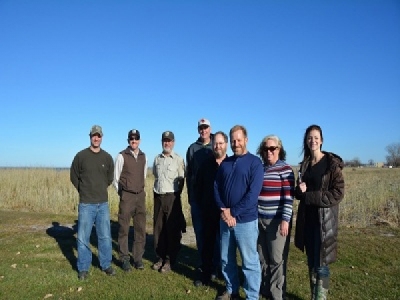
Posted on March 22, 2018
By Virginia Cody, dvids
Sometimes, when people at different levels of government put their minds together, good things happen.
Take what’s going on at Port Clinton, Ohio, where the Ohio Environmental Protection Agency (OEPA), U.S. Fish and Wildlife Service, the City of Port Clinton, and the U.S. Army Corps of Engineers have joined together to restore 12 acres and add another 1.4 acres of coastal wetlands on Lake Erie.
Thirteen-plus acres may not seem like a lot, but when you consider that Ohio’s lost nearly 90 percent of its wetlands due to 19th and 20th century development, it’s a start.
According to Chris Akios, Ecologist and Project Manager with the U.S. Army Corps of Engineers Buffalo District, Port Clinton sits along both the Mississippi and Atlantic migratory flyways. Once the wetlands there are restored, more than half the migratory species in North America will once again be able to see Port Clinton as suitable stopover habitat.
“Coastal wetlands along the Great Lakes provide important feeding opportunities to migrating birds,” Akios said. “They often utilize coastal wetlands in the Great Lakes much in the way vacationers fuel up at the last gas station before an isolated stretch of their journey.”
As of right now, the Port Clinton wetlands are anything but enticing to migratory birds.
Port Clinton’s Mayor Hugh Wheeler stated that an inordinate number of invasive plant species have saturated the area, in particular, Phragmites.
Phragmites are perennial grasses that quash the plant diversity needed for a thriving ecosystem.
Added to this lack of plant diversity, the acreage lacks ridges, mounds, channels, depressions, and large woody debris animals need for survival. Topping that off is that on three sides of what were once wetlands are manicured lawns that provide little by way of suitable habitat for migrating or breeding birds.
Funding for the project has been a little tricky, said Akios. Initiated in 2016 at the behest of Mayor Wheeler, complete restoration of the wetlands is expected to cost around $1.2 million. Around $780 thousand will come from the federal government; the remainder will be shared by the Ohio Environmental Protection Agency and the City of Port Clinton.
“We had the idea to go through the Water Resource Restoration Sponsor Program for some of the necessary funding,” Akios said. “We saw this as a new opportunity for OEPA and the Corps to combine resources with local stakeholders in support of restoration in Ohio.”
“Our share is $91K,” said Mayor Wheeler.
“Around $266K will come from OEPA, and the rest will come from the Corps.”
According to Angela Adkins, OEPA Environmental Planner, the Water Resource Restoration Sponsor Program (WRRSP), which came into being in 2000, is a sponsorship program.
“Ohio EPA gives the sponsor an interest rate discount of up to .1% and advances a portion of this interest to fund the WRRSP project,” she said.
In this case, the City of Port Clinton is the nonfederal sponsor.
“To qualify for funding, a project must either by itself, or in concert with other past, present, or future projects, result in the full protection or restoration of aquatic resources,” she said.
Adkins added that the WRRSP seeks the “best of the best” kinds of projects.
Mayor Wheeler said that the project will involve digging out the entire area of Phragmites and other non-native grasses. Then Corps of Engineers-contracted workers will reconstruct the area so it has dunes and low areas where water will remain.
“Wildlife will be able to come to the wetlands and stay there,” Wheeler said.
The Corps will monitor and provide adaptive management under the Great Lakes Restoration Initiative for five years after the project is completed. The U.S. Fish and Wildlife Service, which already manages around 10,000 acres of wetland habitat in Ohio, has offered to take on management of these wetlands under a cooperative management agreement. Until then, FWS will provide technical guidance on the overall plan for the property will be.
“They have the boots on the ground knowledge of the native plants that would maximize benefits to birds in coastal wetlands of this region,” said Akios. “This is very valuable information and important to our project’s success.”
Fish and Wildlife Service funding to support the partnership agreement will come from congressional appropriation to support the mission of the agency, said Jason Lewis, Refuge Manager for the Ottawa National Refuge Complex in Ohio, “so we can provide maintenance and operational support to the City of Port Clinton to offset management costs to the city.” Lewis also stated he and his staff are fully prepared to provide “technical consultation on both the hydrological and biological objectives” of the restoration project.
“Wetlands are the ‘kidneys’ of Mother Nature,” explained Lewis. They can absorb excess nutrients such as phosphorus and nitrogen and help reduce unwanted nutrients in our streams, rivers, and Lake Erie.
Lewis said he’s hoping this new visibility in Port Clinton helps Fish and Wildlife connect with the communities it serves along the Lake Erie shoreline.
“Our mission is to conserve, enhance, and protect wildlife and their habitats, including wetlands for the continued benefit of the American people,” Lewis said.
Akios said the construction contract for this project is due to go out for bid sometime in August with construction starting soon after.
“We expect to have the project completed by the end of the year,” Mayor Wheeler added.
Wheeler also pointed out that the overall feeling among Port Clinton residents is very positive, particularly those people who own homes adjacent to the wetland site.
“They’re happy it’s going to be done,” he said.
Source: dvids





